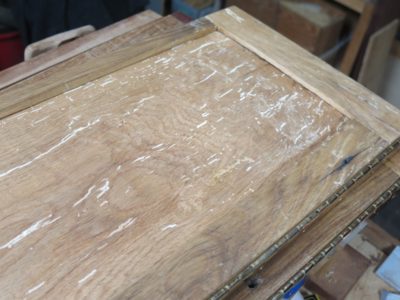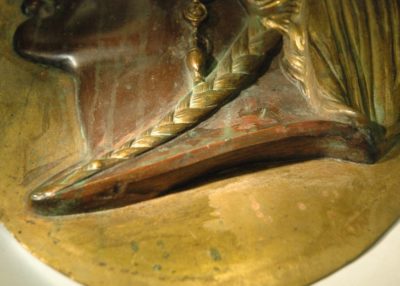Picking Away (At Silica Deposits)

After much noodlin’ and experimenting I wound up in the place of resolving the problematic silica flatting agent deposits in the interstices of the antique wood of Mrs. Barn’s clothes cupboard doors. Unfortunately the destination was a place I did not necessarily want to go — picking out all the offending material with dental tools.

A few hours of work (I did not keep track as I popped in and out on the process) was all it took to get things back to a good place from which to proceed.

I really did not mind, for most of the past forty years I became accustomed to delicate, tiny-scale work, frequently under a stereomicroscope. I guess if you find such work intolerably tedious, art conservation is not a good career path for you. At least in this case I was not tethered to one of my microscopes, reading glasses and good directional lighting were all I needed.

One project from the past came to mind as I was picking out all the bits of crumbly whitened varnish. It was a late 19th Century Alexander Roux cabinet that had been gifted to the Institution, needing a fair bit of work. The original base had rotted off due to the cabinet sitting on the mud floor of a basement, so it needed a new base along with all the bronze mounts. I sculpted the wax patterns for the new mounts and cast the bronze myself.

But, the most nettlesome aspect of the project was the intractable accretion of untold layers of linseed oil-containing furniture polish on top of all the surfaces including the patinated copper and bronze on a large cameo medallion that was the visual centerpiece of the cabinet (the main purpose of the cabinet was to hold either one piece of sculpture or a flower arrangement on the center of the top). Over the years the linseed oil had hardened into something akin to Scotty’s transparent aluminum due to imbibing metal from the substrate leaving an encasing residue essentially un-removable by ordinary means. The only effective technique was to formulate and slather an ultra-high pH Laponite gel, which coincidently removed the patination on the underlying substrate. That was not a desired outcome.

Eventually I wound up fabricating some ivory scrapers to chip off the deposit, working entirely underneath a microscope to protect the undulating surfaces of gilded bronze and patinated copper. The ivory scrapers looked like dental tools and were used because they would chip off the rock-hard contaminate yet not scratch the substrate. In the end I was exceedingly pleased with the outcome.

But back to Mrs. Barn’s cabinet doors. After removing all the deposits with the dental tools and scouring the surface with a wire brush, it was time to try applying a new coat of gloss oil resin varnish.
Whew. I can now proceed to completion, building up the finish to a matte presentation.


Join the Conversation!